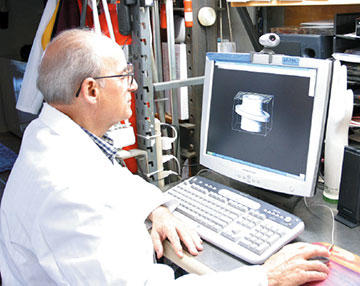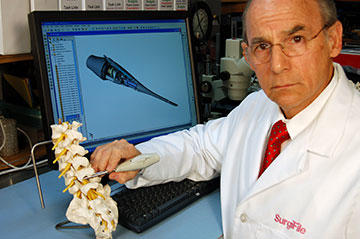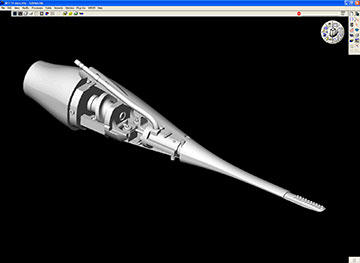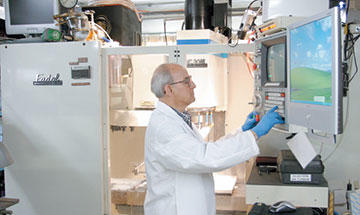
Rick Harp—founder-president of Carlsbad, CA’s Innovative Medical Designs Inc., a company that designs and produces tools for use by the medical device industry—literally took the admonition, “Physician, heal thyself,” to heart.
But Rick is not a physician. Instead, he’s a rare individual who is both a mechanical design engineer and a “master machinist,” who has spent the past 10 years designing and building a surgical tool that will allow neurosurgeons to repair people’s backbones without destroying the nerves in the spine. Harp’s motive for taking on such a job was simple. He sustained severe damage to his neck when he was rear-ended in 1996.
“In 1996 I had been hired as a consultant to solve a design problem for the Braun Thermal Scan Company, the company that built the Tympanic Temperature instrument that they put in the ear,” he says. “They had a new model they just couldn’t figure out, and I solved it. I was on my way to make a presentation to them when I was rear-ended by a lady in a four-door Cadillac. I had stopped at a traffic light and bent over for a quick look at my presentation when she hit me. The result was I sustained a pretty severe neck whiplash problem.”
Over the next year Harp underwent extensive therapy, but none of it was able to solve his problem.
“Multiple doctors came to the conclusion that I needed what is called a cervical fusion,” he says, “and possibly a lumbar (lower back) operation. Basically, what they wanted to do was to take a piece of bone from my hip or from a cadaver and place it where the damaged disc is in my neck. The reason they wanted to do that was to open up the tubular canals called foramen, which are tunnels where the nerves pass through the spine. The bottom line was that my nerves were being pinched and my hands were going so numb I couldn’t operate my machining center anymore.”
But Harp didn’t jump at the chance to have his spine rebuilt without any real hope of success.

“Sometimes those operations work and sometimes they don’t,” he says. “I kept going to one doctor after another and asking, ‘Why do you have to perform this fusion procedure?’ Their answer was that they wanted to relieve the compression on the nerves. So, I asked, ‘Why can’t you just go in and open up that bony tunnel next to the nerve?’ Their answer was, ‘There isn’t any known instrument that can do that.’ That answer shocked me. In the past I had spent ten years designing surgical tools for American Hospital Supply, so I said, ‘There’s going to be one, because I’m going to design it.’ That’s how I got started on this project.”
Rick Harp’s background was uniquely suited to his taking on such a project. “As a young man, as a mechanical design engineer working for the big-three automakers, I used to go talk to the guys in the machine shop, and what I learned from them was that if I wanted to be a really good design engineer, I needed to learn to build what I designed. As a result, over the years I became what some used to call a master machinist. And since then, whenever I hire a young design engineer to help me, I make sure they learn to operate my Fadal and to use the Gibbs cad/cam software that runs it. I tell them, ‘You want to be a good designer, learn to be a good machinist, too.” After 10 years in in Detroit, Harp came to California and spent 7 years working as an aerospace designer developing high-tech delivery systems for nuclear weapons for such people as Northrup Grumman. About 25 years ago he took on a consulting job for American Hospital Supply and became entranced by the problems of designing medical devices.
“I was planning to go on vacation at the time,” he recalls, “but the chief engineer at American Hospital Supply asked me to spend just two weeks working with them to solve a problem they had. I agreed and that did it. I got hooked and spent the next ten years with them.”

Although Harp is not a physician, after getting involved with the medical field, he was mentored for 10 years by an orthopedic surgeon who let him attend numerous operations in the operating theater.
In 1992 Harp formed his own company, Innovative Medical Designs, Inc.
“I set my company up with a Fadal VMC 3016 and a GibbsCam package,” he says. “I did that because I was a medical products designer and because of my belief that a good designer ought to be able to build the the products he designs. I used the equipment to build and prove out the products I designed for my clients.”
Over the next few years prior to his accident Harp worked and pursued the passion of his life, which was high-speed sailing.
“If it floats, I love it,” he says. “In fact, when the lady rear-ended me, I was busy designing a boat hull that can physically change shape while under way. It would go from a buoyant hull to a planing hull. My dream was to enter it into the America’s Cup. But that all ended with the accident in 1996. That accident changed my life forever.”
One of Harp’s closest friends was a neurosurgeon with whom he sailed regularly. So, once he began trying to design a tool that could be used to operate on his spine, he ran his latest ideas past his friend during their Sunday sailing outings.
“I always brought along sketches, drawings and models,” he says. “When we finished sailing, we would go for a hamburger and a drink and I would run my ideas past him. Time after time, for five years my friend would say, ‘Sorry, Rick, that won’t work. You’ll kill the patient.”

Finally, however, in 2001 Harp presented his friend with an idea that raised his eyebrows in surprise.
“I showed him a little aluminum model of what I now call the SurgiFile,” he says. “My friend pushed back from the table at the yacht club and said, ‘Rick, I think you have something here.’ And so we took the model to a Dr. Howard Tung, who was assistant professor of clinical neurosurgery at UC San Diego Medical Center. When Dr. Tung saw the model, he said, ‘My God, I think that can work!’ And we were off to the races.”
During the following years Harp had to solve several major design problems to get a practical, working SurgiFile.
“First, I had to find a way to protect the nerves from the tool that would be used to cut the bone and open up the canal around the nerves,” he says. “I finally solved that by inventing a thin, flat file that operates on top of a metal shield that protects the nerves below. The file cuts away bone on top while the nerves are pressed down and away from the action, completely protected from damage.”
But then there was the problem of how to drive the file, but not use any kind of rotary motion.
“Rotating files in tight places are dangerous,” he explains. “It’s like a car wheel hitting the street. It tends to skip sideways. In many aspects of surgery that’s not a problem, but wherever a doctor is trying to remove bone that’s close to a nerve or an artery, the fact that this tool can get out of control is literally the kiss of death. A surgeon first has to do no harm. So, I had to find a way to create a flat shielded reciprocating file that could be driven at high speed, but without vibration.”
Harp solved the vibration problem by designing a special toroidal cam follower that he calls a Hybrid Twin Toroid. Without causing undue vibration, the cam follower converts the rotary motion of the drive motor into smooth reciprocating motion to drive the flat file. But there was one last design problem facing Harp.

“That was to figure out how to keep the bone filings from building up on the file,” he says. “For that one I turned to the machine tool designer’s use of through-the-tooling coolant. But in this case I feed pressurized sterilized water through the end of the SurgiFle. It squirts 5,000 times a minute or once for every cycle of the reciprocating file. It keeps the file and the wound clean of bone residue.”
So far the SurgiFile has been tested only on cadavers, Harp reports.
“The SurgiFile was tested on cadavers in Phoenix, Arizona by world-famous surgeons,” Harp says. “It was tested by Dr. Larry Khoo, co-director of the comprehensive spine center at UCLA and the by Dr. Anthony Young, the surgeon who co-wrote the book on minimally invasive spine surgery. Their conclusion was that the SurgiFile may very well fundamentally change the way spine surgery is performed.”
Harp says his company has used up all the original capital available for development of the SurgiFile.
“We’re two to three years away from getting FDA approvals and going into high-volume production,” he reports. “We’re looking for another $10-$15 million of investment capital to keep us going. I believe we’ll get it, because the SurgiFile works and can improve the lives of millions of people with debilitating back problems.”
What about his own back problem?
“I’ll be first in line for surgery with the SurgiFile,” he says. “That’s what this was all about in the first place.”
Wilson Tool International enhances custom part production efficiency through GibbsCAM automation, utilizing macros for rapid programming and standardized processes across its diverse manufacturing sites.
Wallåkra Mekaniska leverages smart manufacturing and AI tools like GibbsCAM and Up2Parts to streamline operations, improve efficiency, and enhance sustainability through reduced energy consumption and optimized processes.
Capristo Automotive has set itself the goal of enhancing luxury sports cars with high-quality accessories and making them even more unique. GibbsCAM was brought on board when the CAM programming of an INDEX G400 YB could not be managed with the existing CAM software.
Northern Maine Community College (NMCC) has implemented a curriculum that equips students with CNC programming skills using GibbsCAM software, allowing students to earn certification within 9 months and achieve a 100% employment rate.
MUT-Tschamber, a mechanical engineering company in Germany, has implemented Sandvik Coromant's PrimeTurning™ technology and GibbsCAM NC programming solution to achieve higher throughput and productivity.
Toolmaker Rieco System Srl achieves greater machining precision and optimized production time with the help of GibbsCAM software.